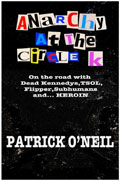I recently co-author a new book that just got published. Which is awesome and cool and I’m stoked to have another book out. And one would think that after all the sweat, hard work, and anxiety that goes along with the launch of a new book that this should be a time for celebration and joy. Unfortunately it has turned into more hard work, anxiety, stress, frustration, and a smoldering resentment.
For the first time in my writing career I have ventured into the world of self-publishing. Back in the day, when I was first coming up, self-publishing was considered (and to some still is) what amateurs and hacks resorted to when they couldn’t get their work accepted by the established literary world. When I was in grad school self-publishing was referred to with distain and labeled the “kiss-of-death.” As if you ventured down that forbidden road you were never getting invited to sit at the grown-ups table. However recent numbers have the odds of getting published at 1%—meaning one out of a hundred submitted books gets published by traditional publishers.
Meanwhile every year writers and agents lament on the current state of publishing and how it isn’t what it used to be (only they’ve been saying that every year for the last thirty years). While continuing to publish the same content, or different version of the same content, that they have always published; which may have a lot to do with deteriorating sales and floundering expansion. Sadly a huge component is that no one reads any more, or maybe it’s more accurate to say that considerably less people are reading. Especially books. Yet however you want to look at it the fact remains that America is on a steady decline for cerebral pastimes. The prevailing psycho-political climate continues to embrace anti-intellectualism, resulting in an overwhelming distain for anything educational. Add that to the overabundance of inane free internet content, the near total reliance on social media for information, and the constant and insipid television programing bombarding everyone’s brain and you can hear the death toll ringing for the general public’s consumption of all things literary.
Which for the publishing industry translates into traditional books sales are way down. Consequently literary advances have gotten lower and publication runs smaller. Yet agents still take the same 15% and publishing houses continue to expect books to “perform” or they get remanded and disappear. In the end of this one-sided dance the author is either heavily promoted or left out in the cold demoted to the Indies or lesser “boutique” publishing houses.
Sadly the publishing industry is still working with a very outdated business model. Leftover from “the golden era” of publishing (1940’s to mid-80’s) when the novel was king, popular monthly magazines published fiction, and authors were a mainstay of late night TV talk shows. But if you’re not the grammar challenged fiction hack Dan Brown or mega-author J.K. Rowling then your publishing house tends to be tightfisted allocating the needed money to promote the hell out of you. Instead they pick a few titles a “season” and focus all their marketing efforts into only those books. Leaving the rest to fend for themselves. If you were a manufacturer of anything else and you used this marketing strategy the industry would think you just didn’t know how to run a business. Because if you have 10 products and only advertise 1 the other 9 are bound to fail and you will lose money.

But even before that happens the road to getting published is such a convoluted mess geared solely in favor of the publisher that again one has to shake their head in amazement that it’s still the way the business is conducted. Everything is run on a ridiculously slow and bloated schedule. Potential authors submit work, agents act like they’re doing the author a favor by agreeing to read their work, the turn around time is months (maybe even a year), and then if and when the book is sold it’s another year and a half before that book even makes it to market. And I don’t even want to get into royalties and advances because that just gets depressing and well, it’s safe to say that all us writers all working for far below minimum wage.
Now all one has to do is look back at the music industry before it imploded to get an idea of where this is all headed. The “talent” (that would be the writer) gets nothing (exploited), minus the 15% agent fee (organized crime calls this a “skim” meaning they take a percentage off the top before anyone else gets their cut), while the publisher, bookstores, and distributors devour the remaining 80% (but I thought they were losing money?). Which is almost exactly what the music biz was doing back in the ‘90’s and then bam… free file sharing hit the internet closely followed by streaming radio and they saw their profits crash and burn. Sadly there was a way out for them but they chose to ignore it, because their top-heavy business model had survived for decades and they just weren’t capable of envisioning another way of doing business. Seriously if they’d built their own download platforms to distribute and stream “their” music then they’d still be ruling the roost. But they left it up to someone else and guess who got screwed? Well, the artist of course, but that’s always the case. No, it was a huge blow to their greedy business model and long story short they’ll never see those big payoff glory days again.
But I digress here. Let’s get back to the literary world and publishing. The advent of eBooks and their downloads, the subsequent decrease in brick and mortar stores, and of course the lack of readers had the industry poised on the edge of a financial chasm staring into the void of diminishing sales. Yet much like the pre-mentioned music industry the publishing world never considered that maybe their “top-heavy business model” was the to blame. Instead, somewhere around the late 1990’s, they let a little known internet start-up, Amazon, force its way into everyone’s lives. Labeling itself as “the world’s largest bookstore” even though it wasn’t a “real” store, Amazon started selling a shit-ton of books. Of course the publishing industry welcomed them with open arms as their savior. And just like with the music industry and file sharing and downloads Amazon provided a new business model and no one had to change anything. It was business as usual. Or so they thought. Except as soon as Amazon realized the power their sales held over the literary world they began calling the shots.
Unfortunately this is a business model that many large retailers take to dominate any given market. They draw the supplier in with the ability to sell their goods, and then once those profits are realized and the seller is hooked, they demand a higher percentage or threaten to stop selling said product. And here in lies the rub. At this point in publishing getting a smaller slice of the profit was better then no profit. In reality Amazon had handed publishers a huge revenue stream without having to make any investments or take any risks. So even though this arrangement probably left a bad taste in their collective mouths they saw the distribution writing on the wall and just had to suck it up and take whatever Amazon was offering.
And now fast-forward to 2021. I’ve co-authored a new book on writing and we were looking for a potential publisher. Never having been in love with the publishing industry my co-author and I decided to put the book out on our own. We chose an “on demand” publisher that could handle hard copies as well as eBooks. The set-up was affordable. The promise was that all the major online book retailers would be able to sell our book (and indie brick and mortar stores could order it). We set the price and allowed for a not ungenerous 35% of the sales to go to the retailers. It took less then three months to get it up and running. Upon release Barnes and Noble had our book out almost immediately. Then came IndieBound, Better World Books, Bookshop.org, Abe Books, Book Depository, Apple Books, and Alibris. We were live and it was time to announce our book to the world.

But when we looked at Amazon our book was listed on its website, only it was labeled as “Temporarily Out of Stock” and had been reassigned to a third party seller with a heftier price tag, shipping costs, and a three week (or more) wait for delivery. Which didn’t make a whole lot of sense. How could a book that had just been released be out of stock? Not to mention its print on demand, there is no stock, per se. So what was going on here?
Initially we contacted Amazon and this was the response:
“The reason the third party pricing is displaying is because your book is currently Temporarily Out of Stock through the original distributor. To update the availability, we need you to contact your publisher/distributor directly for assistance. When you publish a book with a third party as the publisher or publishing house, the distribution rights and the administration of your book are given to them. All actions related to the book (price, availability, formatting, or other changes in different features) will need to be submitted using the same platform where your book was uploaded.”
Okay, so if that was true then why was our book available through all the other online sellers?
Feeling very frustrated we contacted our publisher.
“Unfortunately, we have no control over what retailer Amazon chooses to prioritize on their page. Amazon seems to favor retailers which have stock or who may have a shorter shipping time, rather than the cost of the book, though how they make those decisions is proprietary to them.”
Hmmm, so what the fuck?
Kindle Direct Publishing (KDP) is Amazon’s self-publishing platform for kindles and print-on-demand paperbacks. They advertise giving the author 60% of the royalties and claim everything else is free. Yet that’s only if you stay on the Amazon platform. If you want to sell elsewhere then you need their “expanded distribution” that requires your give them 60% of the royalties and the kicker is they only sell kindles so all other eBooks are shit out of luck.
Now because of the above issues we had decided on publishing with a competitor. They offered wider distribution and for eBooks they provide mobi (Adobe, Apple, Kobo, etc.), epub (Barnes & Nobles’ nook), and kindle. They allowed us to set the fee for sellers and all was good until the book launch. And then bam, we’re listed as “Temporarily Out of Stock” and we’re dead in the water.

So what we have learned here is that similar to Amazon’s dominance over the publishing industry they also have their knee on the neck of self-published indie authors. In other words they want a bigger piece of the pie (even if it’s a small pie like ours). Their annual revenue for last year was a staggering $386 billion and all I could think of was, they really need my money that bad? But I guess that’s the way the rich get even richer. So again we went back to our publishers and they said:
“Amazon chooses the data that they choose to display on their sales page. To maximize your availability, we recommend you list your titles with a standard wholesale discount of 50-55% and a returnable status. These are the biggest factors in Amazon choosing to list your title directly instead of through third parties.”
Which translates to if you give Amazon a bigger wholesale discount they’ll stop fucking with your book. In the end we gave Amazon 55% of the royalties and had to agree to accept returns (like who the hell returns books?). And low and behold a week later we were in stock at the original price and shipping was 1-2 days, even less with Amazon Prime.
Obviously Amazon isn’t satisfied with what it just rakes in from traditional publishers. They’re so greedy they also demand over half the total profits from self-published authors. They’ve shown that they’re willing to go as low as possible, blocking sales in order to force anyone out of business that’s not willing to pay. Of course we could not sell on Amazon. There are companies like Bookshop.com that are directly competing with Amazon. However Amazon still sells 50% of all books sold in America. So until companies like The New York Times stops directly linking their book reviews and best seller lists to Amazon there essentially is no competition and Amazon will continue to squeeze every last drop of money that they can from everything literary, no matter how or who is being publishing.
Meanwhile the so-called “dying industry” of American publishing saw a net revenue of just under $26 billion dollars in 2020. At the same time Amazon’s total revenue topped $108 billion.
No matter how you slice it or who is in charge… the artist always gets screwed.

